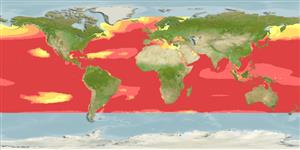>
Lampriformes (Velifers, tube-eyes and ribbonfishes) >
Lampridae (Opahs)
Etymology: Lampris: Greek, lampros = light (Ref. 45335).
Environment: milieu / climate zone / depth range / distribution range
Écologie
marin bathypélagique; océanodrome (Ref. 51243); profondeur 0 - 500 m (Ref. 89422), usually ? - 366 m (Ref. 5951). Deep-water; 75°N - 60°S, 180°W - 180°E
Worldwide in tropical to temperate waters (Ref. 57923). Western Atlantic: Grand Banks and Nova Scotia (Canada) to Florida (USA), Gulf of Mexico and the West Indies (Ref. 7251) up to Argentina (Ref. 47377). Eastern Atlantic: Norway and Greenland to Senegal (Ref. 6737) and south of Angola (Ref. 6476) also Mediterranean. Eastern Pacific: Gulf of Alaska to south of southern California (Ref. 265). A single capture in South Georgia marks an incidental occurrence in Southern Ocean.
Taille / Poids / Âge
Maturity: Lm ? range ? - ? cm
Max length : 200 cm TL mâle / non sexé; (Ref. 5188); common length : 120 cm TL mâle / non sexé; (Ref. 5217); poids max. publié: 270.0 kg (Ref. 5188)
Description synthétique
Clés d'identification | Morphologie | Morphométrie
Épines dorsales (Total) : 0; Rayons mous dorsaux (Total) : 48 - 55; Épines anales: 0; Rayons mous anaux: 33 - 41; Vertèbres: 43. Caudal fin broadly lunate; pectorals long and falcate; pelvic fins similar to pectoral fins in shape and a little longer (Ref. 6885). Dark steely blue dorsally shading into green with silver and purple iridescence, belly rosy, body covered with silvery spots in irregular rows, light mottling on caudal and dorsal fins; vermillion on fins and jaws, golden around eyes (Ref. 6885).
Oceanic and apparently solitary (Ref. 6737). Epi- and mesopelagic (Ref. 58302). Feeds on midwater fishes and invertebrates, mainly squids (Ref. 6737). Probably spawns in the spring (Ref. 6885). Occasionally taken as a by-catch of tuna fisheries. Considered a good food fish (Ref. 5242); marketed fresh and frozen; prepared as sashimi (Ref. 9987). Swims by flapping the pectoral fins (Ref. 36731).
Palmer, G., 1986. Lamprididae. p. 725-726. In P.J.P. Whitehead, M.-L. Bauchot, J.-C. Hureau, J. Nielsen and E. Tortonese (eds.) Fishes of the north-eastern Atlantic and the Mediterranean. UNESCO, Paris. Vol. 2. (Ref. 6737)
Statut dans la liste rouge de l'IUCN (Ref. 130435: Version 2024-1)
Menace pour l'homme
Harmless
Utilisations par l'homme
Pêcheries: intérêt commercial mineur; pêche sportive: oui
Outils
Articles particuliers
Télécharger en XML
Sources Internet
Estimates based on models
Preferred temperature (Ref.
123201): 5 - 19.9, mean 12.1 °C (based on 1423 cells).
Phylogenetic diversity index (Ref.
82804): PD
50 = 1.0000 [Uniqueness, from 0.5 = low to 2.0 = high].
Bayesian length-weight: a=0.01995 (0.00906 - 0.04395), b=3.01 (2.83 - 3.19), in cm total length, based on all LWR estimates for this body shape (Ref.
93245).
Niveau trophique (Ref.
69278): 4.2 ±0.62 se; based on food items.
Generation time: 5.0 ( na - na) years. Estimated as median ln(3)/K based on 1
growth studies.
Résilience (Ref.
120179): Faible, temps minimum de doublement de population : 4,5 à 14 années (Assuming tm>4).
Prior r = 0.28, 95% CL = 0.18 - 0.42, Based on 1 data-limited stock assessment.
Fishing Vulnerability (Ref.
59153): High vulnerability (60 of 100).
Climate Vulnerability (Ref.
125649): Moderate vulnerability (38 of 100).
Nutrients (Ref.
124155): Calcium = 13 [4, 32] mg/100g; Iron = 0.295 [0.127, 0.889] mg/100g; Protein = 21.3 [16.9, 24.1] %; Omega3 = 0.148 [0.055, 0.397] g/100g; Selenium = 21.5 [7.0, 69.8] μg/100g; VitaminA = 9.27 [1.00, 83.81] μg/100g; Zinc = 0.245 [0.123, 0.529] mg/100g (wet weight); based on
nutrient studies.
